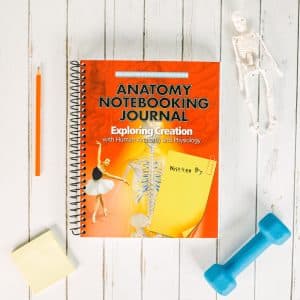Description
Exploring Creation with Human Anatomy and Physiology is a homeschool science curriculum for elementary students. In this anatomy course, your students will do a deep dive into the unique design of their own body–both inside and out–and how they can keep it working well! They’ll also explore a range of topics such as human DNA, cell anatomy, and body systems through the curriculum filled with vivid graphics, interactive lessons, and hands-on projects.
Curriculum Overview
Apologia’s Exploring Creation with Human Anatomy and Physiology course takes both an academic and practical approach to best teach your students about the human body. As they engage with the lessons, projects, and experiments, your student will better understand the complexity and purposes of the human body’s design and how best to care for their own body.
This anatomy course begins with a brief history of medicine and then gives your student a peek into cells and DNA. Using vivid graphics and hands-on activities to make learning come to life, your student will study and explore various body systems, nutrition, and health, how God designed their immune system to protect them, and what makes them a unique creation of God.
This elementary Anatomy and Physiology course has 14 lessons that cover the following topics:
- Lesson 1: Introduction to Anatomy and Physiology
- Lesson 2: The Skeletal System
- Lesson 3: The Muscular System
- Lesson 4: The Digestive and Renal Systems
- Lesson 5: Health and Nutrition
- Lesson 6: The Respiratory System
- Lesson 7: Life in the Blood
- Lesson 8: The Cardiovascular System
- Lesson 9: The Nervous and Endocrine System
- Lesson 10: The Nervous System Extended
- Lesson 11: Your Senses
- Lesson 12: The Integumentary System
- Lesson 13: The Lymphatic and Immune Systems
- Lesson 14: Growth and Development
Textbook
Packed with vivid photos and a variety of hands-on activities and experiments that bring Human Anatomy and Physiology to life, the student textbook provides engaging hands-on activities to help them solidify the concepts they are learning.
Some of the activities and experiments your student will complete in this course include making an edible model of a cell, testing the bacteria content around the house, finding their blood type, and even building a stethoscope.
All the activities and experiments in this anatomy course use easy-to-obtain household items and truly make the lessons come alive!
Notebooking Journal
The Anatomy and Physiology Notebooking Journal provides everything your student needs to complete this study of the human body. It will serve as your child’s place to complete every assignment.
What’s Inside the Anatomy Course?
- A Suggested Schedule with a breakdown of exactly what students need to complete each week
- Templates for your student to record what he or she learned in each lesson, using both words and illustrations
- Note-taking pages with prompts to help teach the student how to identify and record important information from the text
- Creative templates for completing the notebooking assignments
- Project Pages and other sheets for your student to use to keep records of experiments, projects, and activities completed throughout the course
- Beautiful, full-color Miniature Books for your student to create, encouraging him or her to record facts and information learned in each lesson
- Helpful and engaging graphics to help your student visualize and understand concepts
- Scripture copywork in both cursive and print
The Benefits of Using a Notebooking Journal
- Facilitates retention and provides documentation of your student’s education. The unique personal written and artistic expressions incorporate both sides of the brain.
- Allows flexibility for multilevel learning. A twelve-year-old student may write an essay and make an elaborate illustration, while a six-year-old may write one sentence with a stick-figure drawing.
- Improves writing skills and penmanship.
- Helps students record experiences, observations, and thoughts.
- Engages students in the scientific process.
- Provides a written history that students can reference as they explore new subject areas.
- Gives your students a place to record and organize experiences and observations.
- Provides a place for students to review their notes, create opinions, and draw conclusions about how their world works.
Audiobook
The audiobook version of the Exploring Creation with Anatomy and Physiology textbook is the perfect accompaniment to the textbook for students who are auditory learners, slow readers, or have learning challenges that make reading difficult.







